So that the grave is not bare even in winter, we have put together an overview of the most beautiful hardy grave plants for you.

the grave planting in winter presents many of the bereaved with special challenges: Because the persistent cold is a nightmare for many plants and so the selection of grave plants is quite limited. At the same time, the grave of your loved one should also look neat in winter. We will tell you here how you can create an attractive and varied grave planting in winter.
As fall draws to a close, it's time to prepare your grave planting for winter. Here you will find the most important points that must be observed.
contents
- Grave planting for the winter: you should pay attention to this
-
Hardy grave plants
- 1. Little Winterling
- 2. Waldsteinia
- 3. fat chicken
- 4. periwinkle
- 5. snowdrop
- 6. Carpet Cotoneaster
- 7. snow heath
- 8. Christmas rose
- 9. checkerberry
- 10. heather
Grave planting for the winter: you should pay attention to this
So that a grave planting remains appealing over the winter, a fall cleaning be helpful: The autumn leaves should first be raked together in and around the grave and on the compost be disposed of. Faded flowers and diseased plants should also be removed - this not only ensures a more appealing overall picture, but also minimizes them the danger that diseases and pests will spread to the new winter planting or even spread more strongly in the following spring be able. Last should be those sensitive to cold summer flowers replaced with hardy plants. These often stay green even in winter and thus prevent the grave planting from looking sparse and empty.
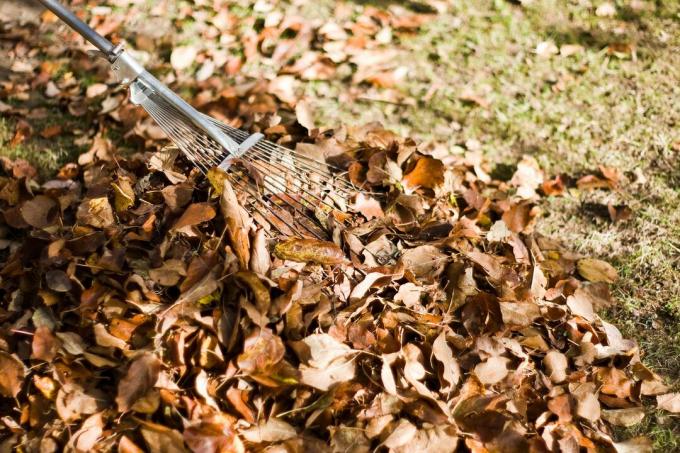
Hardy grave plants
So that the grave planting looks appealing and not desolate even in winter, one should rely on hardy grave plants. We have compiled the most beautiful plants for grave design in winter for you here.
1. Little Winterling
When the Little Winterling (Eranthis hyemalis) stretches out its heads in February, winter is already drawing to a close. Nevertheless, the flowering garden plant is a great addition to the winter grave planting. The plant is most impressive when there is still snow and ice on the ground – then it glows the yellow flowers are particularly intense and form a wonderful contrast to the white snow landscape. In addition, the ground cover as particularly grateful, since he needs almost no care.
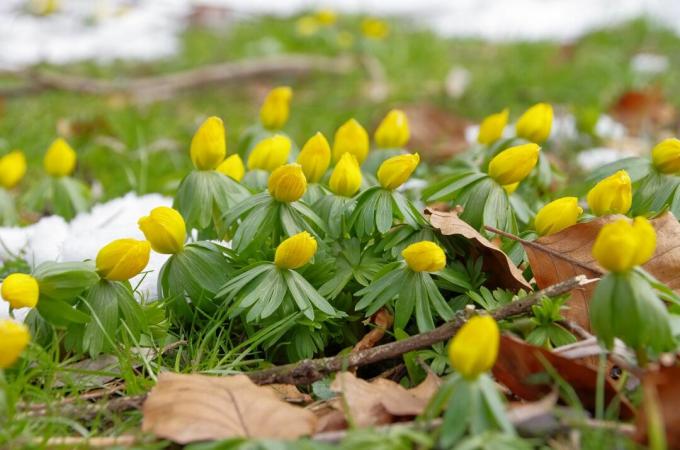
2. Waldsteinia
Easy-care, robust and evergreen - these three properties make the Waldsteinia (Waldsteinia ternata) a particularly popular groundcover in grave planting. Even in winter, the perennial plant scores with its light green carpet of leaves, which reliably suppresses weeds. If you give the Waldsteinia a place in the grave planting in spring, you will also get it rewarded: From April, the plant, also known as golden strawberry, forms countless yellow flowers the end.

3. fat chicken
the fat chicken (sedum), also known as stonecrop, is a popular plant in grave design. No wonder, after all, it is not only easy to care for and robust, but is also ideal for planting all year round. The Fette Henne can also score points in winter with its attractive appearance and variety: Varieties such as the Felsen-Fettblatt (Sedum cauticola), the spatula-leaved stonecrop (Sedum spathulifolium) and the Great Garden Stonecrop (sedumhybrid 'Autumn Joy') are frost hardy down to -20 °C and are real eye-catchers when covered with hoarfrost.

4. periwinkle
The name of the periwinkle (Vinca minor) already indicates it: the leaves of the small plant are an attractive dark green all year round. Especially in winter, the periwinkle is a popular plant for grave design, which can be used excellently as a structure plant or hardy ground cover. Its absolute robustness also makes periwinkle so popular in grave planting. Who the plant also for the Grave design in spring wants to use, also gets to see the countless starry flowers of the plant.
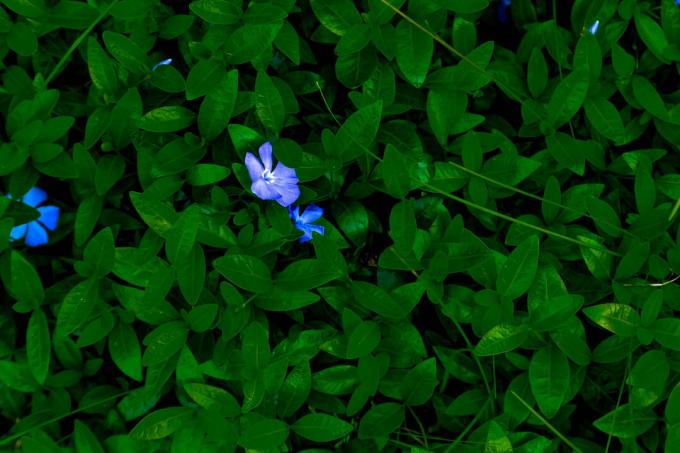
5. snowdrop
The Snowdrop (Galanthus) is one of the flowering plants that can only be seen at the end of winter: between January and March, the small flower shows its white blossoms and thus heralds spring. The snowflake likes a particular location, tends to run wild and develops an ever-growing carpet of flowers year after year. Snowdrops can be particularly beautifully combined with evergreen shrubs and trees in the grave design. If you want to prevent the plant from spreading on its own, you can also put it in a plant bowl with others winter bloomers, like the different types of heather.
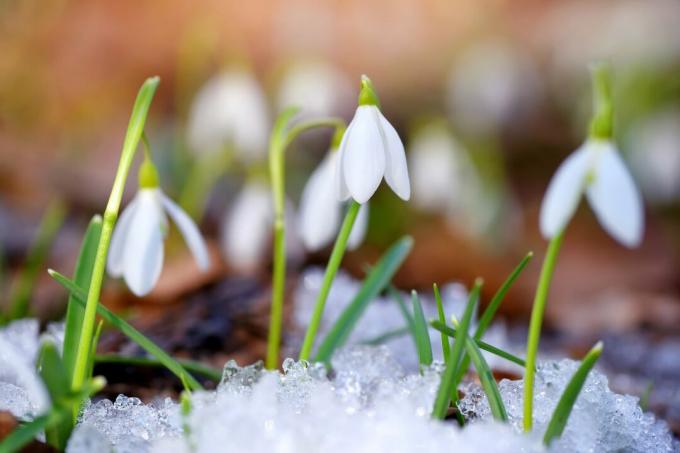
6. Carpet Cotoneaster
If you are looking for an attractive, hardy ground cover for grave planting, the carpet dwarf medlar (Cotoneaster dammeri) find what you are looking for: With its pretty, dark green foliage, the attractive ground cover is perfect as a structural plant. In addition, the cotoneaster scores with impressive, red berries. These captivate, especially in winter, with their striking contrast with the dark foliage. In addition, the carpet cotoneaster is considered to be particularly easy to care for and reliably suppresses annoying things weed. Further hardy ground cover can also be found here.

7. snow heath
For magical splashes of color in the winter grave planting is the snow heath (Erica carnea) the perfect candidate: With their bell-shaped flowers, which are all shades of white up to bright pink, the plant attracts everyone's attention from December to April yourself. At the same time, the snow heather, also known as winter heather or heather, is absolutely easy to care for and very hardy.

8. Christmas rose
As a Christmas plant, the Christmas rose (Helleborus niger) generally known, but it is also ideal as a grave decoration in winter: the elegant white blossoms of the Christmas rose appear from November and shine even in frost and snow. Over time, the plant has developed into a symbol of hope that can be wonderfully integrated into the grave design. They are particularly attractive hardy flowers, when planted together in groups of three. But the combination with snowdrops also makes the robust Christmas rose shine.

9. checkerberry
An attractive look does not always have to go hand in hand with opulent flowers: The checkerberry (Gaultheria procumbens) is a great example of how you can make a grave attractive without any floral decorations. The plant, also known as partridge berry, develops small, fiery red berries in autumn, which linger on the shrub even in winter. In addition, the plant impresses with a great, dark green foliage. When designing a grave, the cloudberry can be used almost universally. Whether as a soloist, in a winterly planted bowl or in combination with the snow heath or the Christmas rose - it always cuts a fine figure.
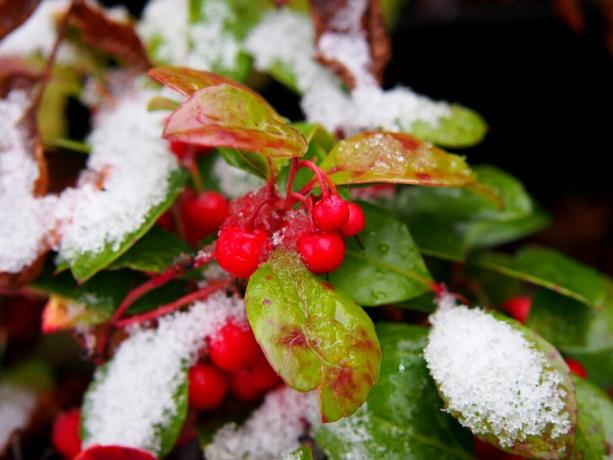
10. heather
From August to the end of January the heather (Calluna vulgaris) with its small, colored flower buds. Despite its small flowers, the hardy plant surprises with an intense color scheme that can range from elegant white and delicate pink to various shades of red and violet. In fact, there are even varieties that not only score points with a beautiful color of the flowers but also with their leaves: some heather varieties have yellow or orange leaves. But not only because of its pretty appearance, the heather is ideal for grave planting in winter - the perennial plant is also surprisingly easy to care for.

After winter, spring is just around the corner. What you at the Grave planting in spring should be considered, you can find out in this article.



